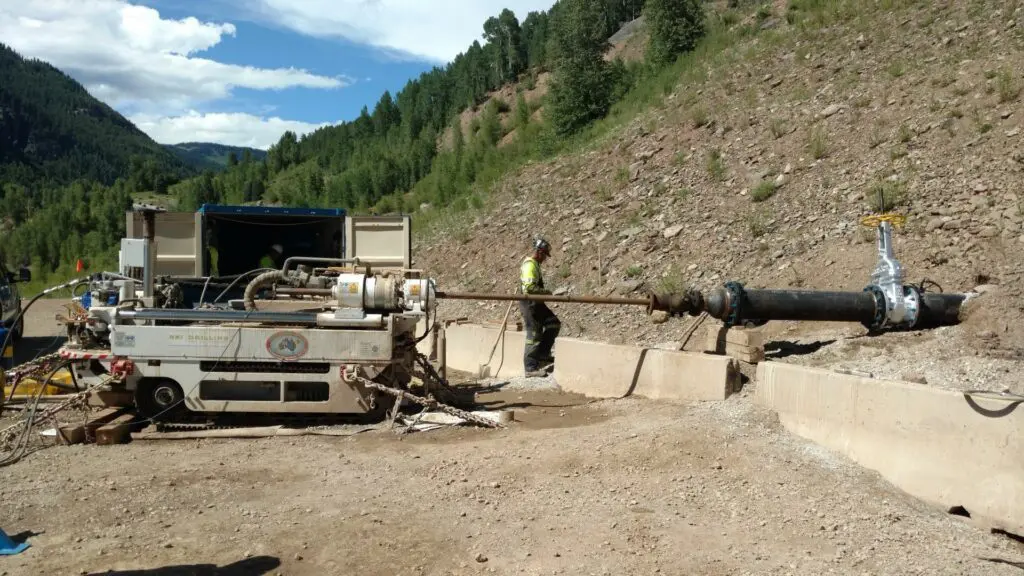Engineering Solutions to Prevent Environmental Disasters by Performing Mine Dewatering and Mine Water Pressure Relief at the St. Louis Tunnel
Over decades, water backed up behind a debris plug, increasing hydrostatic pressure to critical levels. The plug could fail. If this occurred, the water would surge downstream, contaminating rivers with toxic metals such as arsenic and lead.
Key Challenges:
- Environmental Impact: Downstream rivers and ecosystems faced contamination risks, including potentially destroying aquatic habitats and water sources used by communities.
- Regulatory and Financial Pressure: BP faced stringent regulatory oversight and the prospect of significant remediation costs if a failure occurred.
- Geotechnical Complexity: The site’s unstable geology and the challenging geometry of the tunnel posed significant risks to intervention efforts.
| Critical Problems | Details |
| Hydrostatic Pressure | Rising pressure threatened catastrophic failure of the debris plug. |
| Environmental Risks | Toxic metals could pollute rivers spanning three states. |
| Unstable Ground Conditions | Geology made safe intervention complex and risky. |
| Regulatory Compliance | BP needed to meet federal and state environmental safety standards. |
This was not merely an engineering challenge—it was an urgent call to protect natural resources, prevent financial repercussions, and preserve public trust.
Innovative Pressure Relief Wells: Safeguarding the St. Louis Tunnel
Anderson Engineering worked closely with BP to design a robust system for managing water pressure at the St. Louis Tunnel. The solution involved installing strategically placed pressure relief wells to intercept and safely reduce hydrostatic pressure.
Steps Taken:
- Initial Assessment and Data Collection
Anderson Engineering conducted detailed field surveys and hydrogeological assessments to map the tunnel’s structure, measure water pressure, and analyze ground conditions. - Custom Design of Pressure Relief Wells
Advanced modeling tools were used to design wells at precise angles intersecting the tunnel and releasing water without destabilizing the debris plug or surrounding geology. - Oversight During Construction
The project required meticulous oversight to ensure the drilling team adhered to the design. Anderson Engineering supervised the installation, resolving real-time challenges like unpredictable soil conditions and complex geometry. - Pressure Management and Testing
Once installed, the wells were tested to confirm their effectiveness in reducing water pressure. Anderson ensured compliance with environmental safety standards throughout the process.
Innovative Methods:
- Dynamic Modeling: Simulations optimized the placement and angles of the wells.
- Collaborative Approach: Close coordination with BP and drilling contractors minimized risks.
| Solution Milestones | Outcomes |
| Design Completion | Pressure relief wells are designed to reduce hydrostatic pressure safely. |
| Successful Installation | Wells installed with minimal disruption to unstable ground. |
| Pressure Reduction Achieved | Hydrostatic pressure is reduced to safe levels, preventing disaster. |
Anderson Engineering’s expertise turned a high-risk scenario into an effective environmental risk management model.

Environmental Protection and Cost Savings: Outcomes of the St. Louis Tunnel Project
The successful completion of the St. Louis Tunnel project prevented what could have been a devastating environmental disaster. By reducing hydrostatic pressure behind the debris plug, Anderson Engineering eliminated the immediate risk of a catastrophic water release.
Key Metrics and Outcomes:
| Metric | Result |
| Hydrostatic Pressure Reduction | Achieved safe levels, averting a potential failure. |
| Contaminated Water Release Prevented | Protected ecosystems across three states. |
| Compliance | BP met all federal and state environmental safety standards. |
Broader Benefits:
- Environmental Protection: Safeguarded downstream rivers and ecosystems.
- Cost Avoidance: Prevented millions of dollars in remediation expenses and regulatory fines.
- Reputation Management: Strengthened BP’s commitment to environmental stewardship.
A Model for Sustainability: The Broader Impact of the St. Louis Tunnel Project
The St. Louis Tunnel project illustrates how engineering innovation and expertise can transform imminent environmental threats into opportunities for sustainable solutions. By partnering with BP, Anderson Engineering delivered a solution that protected ecosystems, reduced liability, and ensured regulatory compliance.
This project also highlights the broader potential of engineering in addressing challenges at historic mine sites across the region. Through their proactive approach, Anderson Engineering demonstrated the value of precision, collaboration, and technical excellence in solving complex environmental issues.
As communities and companies alike confront the legacies of historic mining, Anderson Engineering remains committed to safeguarding the environment and supporting sustainable development.
Contact Anderson Engineering: Your Partner in Environmental Solutions
If you’re managing environmental risks at historic mine sites, Anderson Engineering is ready to help. Our proven expertise in hydrostatic pressure management, environmental compliance, and geotechnical solutions ensures successful outcomes, even in the most challenging conditions.
Contact Anderson Engineering today to discuss your project and discover how we can deliver innovative solutions that protect the environment and meet regulatory standards. Together, we can tackle today’s challenges while preserving resources for tomorrow.




